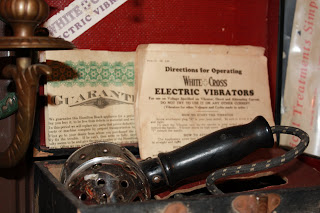Humphrey Brooke, a fifty year old, well respected physician and life long bachelor was not what most would find physically appealing. He was shorter than average and his extremely stooped shoulders didn't help. At the end of his long, crooked nose sat a pair of spectacles and to add to these he was asthmatic and quite socially awkward.
Dr. Brooke was the opposite of twenty year old Felicia Clayton. Felicia was the belle of Liverpool - a stunningly beautiful, kind and charming young daughter of a wealthy shipping magnate. It could be said that Felicia was the Scarlett O'Hara of Liverpool - she could have the heart of any man and was inundated with love letters, gentlemen suitors and proposals of marriage.
The pair first met at a funeral, when Dr. Brooke was introduced to Felicia. He was overwhelmed by her beauty and kissed her hand. He stared at her during the rest of the funeral and she responded by smiling at him a couple times.
Dr. Brooke caught sight of Felicia around town a couple times after this, once when she was coming out of a carriage and again as she walked down the street with a suitor. This second time, while in a suitor's company, she saw Dr. Brooke and waved to him, but not only did she wave but looked back over her shoulder twice to smile at him. The suitor became jealous and reprimanded her.
Dr. Brooke's infatuation with Felicia was now at it's peak. He hurried home and began to keep a journal of his feelings for her and detailing in it, his plans to win her heart.
When the Christmas season came around and Dr. Brooke received an invitation to a lavish Christmas Eve ball, he took the opportunity and lovingly crafted a letter to his beloved Felicia, asking her to attend the ball with him.
She accepted.
Some days later, a friend of Dr. Brooke's, well known womanizer Charles Wilson, came to visit him. During their visit, Wilson asked if Dr. Brooke had any plans for Christmas Eve as he wanted company at a local pub for that evening. He was certain his awkward and unattractive companion would be alone, as usual. To his surprise, Dr. Brooke informed him that he did indeed have plans, ones that involved the most sought after woman in the city.
Wilson was not only shocked but also very jealous. He, too had tried his charms on Felicia - to no avail. Wilson expressed his disbelief and was trying to talk Dr. Brooke out of what he called his "fantasies" when a woman burst in informing the doctor of a medical emergency and it necessitated his immediate attention. On the way out the door, Dr. Brooke produced Felicia's letter of acceptance to the ball and handed it to Wilson.
Angry and more jealous than ever, Wilson started going through Dr. Brooke's belongings and discovered the journal wherein his "friend" had disclosed all his feelings, hopes and dreams for a future with Felicia Clayton. Vindictive and nasty Wilson went home and proceeded to author a letter to Felicia's father. In it, he disclosed their plans for the ball and made his "friend" look as bad as possible, including implications that Dr. Brooke was not only old, unhealthy and a bad catch for any woman let alone the most eligible girl in town, but that he was also mentally unstable.
Mr. Clayton received Wilson's letter, and wrote one of his own to Dr. Brooke.
Come that Christmas Eve of 1910, Dr. Brooke dressed in an expensive and elegant long, purple velvet coat and embroidered waistcoat and fashionably long, narrow trousers. He smoked a pipe and waited until the time finally came to see his dearest when a knock came at the door with a boy delivering the letter from Mr. Clayton. In it, Clayton lied and said Felicia had accepted his invitation out of pity and that she wanted nothing to do with Brooke. The letter closed with the following:
"It is of utmost impropriety for a man of fifty to be indulging in romantic delusions about a girl thirty years his junior. I warn you to cease annoying my daughter and act with the dignity befitting your age and station. If you persist in trying to win her attentions, it will be at great social and professional cost to you."
Following the reading of the letter Dr. Brooke, devastated and completely distraught died of a heart attack hours later. As he fell to the floor, he took down a clock on the mantelpiece with him. When the clock crashed to the floor it broke and stopped at Dr. Brooke's time of death - 10:50 P.M. I guess you could say he quite literally died of a broken heart.
It is said that Felicia ignored her father's commands and went to the ball to look for Dr. Brooke anyway. It seems she was quite touched by his letter. When she could not find him, she left the ball - much to the dismay of the males in attendance.
Since then, it is believed that the spirit of Humphrey Brooke haunts the house on Clarence Street each Christmas Eve. There are strange rappings, an angry voice that curses and cries out from within. Many a passerby has claimed to have seen a man, around fifty years old dressed in Victorian era clothing wandering on the street outside the house.






































